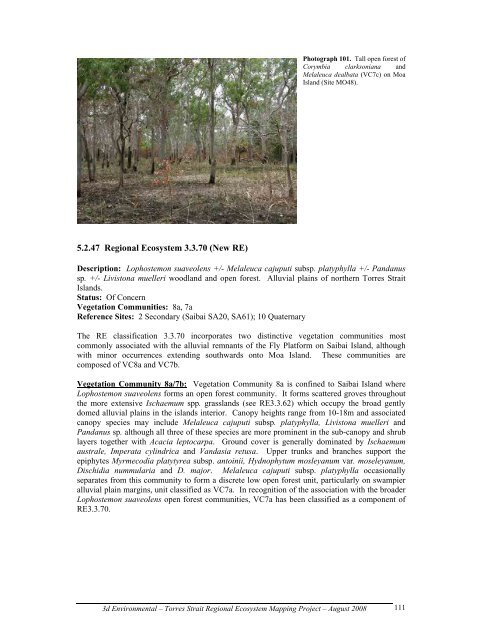Appendix 2 - Vegetation Communities and Regional Ecosystems
Appendix 2 - Vegetation Communities and Regional Ecosystems
Appendix 2 - Vegetation Communities and Regional Ecosystems
Create successful ePaper yourself
Turn your PDF publications into a flip-book with our unique Google optimized e-Paper software.
5.2.47 <strong>Regional</strong> Ecosystem 3.3.70 (New RE)<br />
Photograph 101. Tall open forest of<br />
Corymbia clarksoniana <strong>and</strong><br />
Melaleuca dealbata (VC7c) on Moa<br />
Isl<strong>and</strong> (Site MO48).<br />
Description: Lophostemon suaveolens +/- Melaleuca cajuputi subsp. platyphylla +/- P<strong>and</strong>anus<br />
sp. +/- Livistona muelleri woodl<strong>and</strong> <strong>and</strong> open forest. Alluvial plains of northern Torres Strait<br />
Isl<strong>and</strong>s.<br />
Status: Of Concern<br />
<strong>Vegetation</strong> <strong>Communities</strong>: 8a, 7a<br />
Reference Sites: 2 Secondary (Saibai SA20, SA61); 10 Quaternary<br />
The RE classification 3.3.70 incorporates two distinctive vegetation communities most<br />
commonly associated with the alluvial remnants of the Fly Platform on Saibai Isl<strong>and</strong>, although<br />
with minor occurrences extending southwards onto Moa Isl<strong>and</strong>. These communities are<br />
composed of VC8a <strong>and</strong> VC7b.<br />
<strong>Vegetation</strong> Community 8a/7b: <strong>Vegetation</strong> Community 8a is confined to Saibai Isl<strong>and</strong> where<br />
Lophostemon suaveolens forms an open forest community. It forms scattered groves throughout<br />
the more extensive Ischaemum spp. grassl<strong>and</strong>s (see RE3.3.62) which occupy the broad gently<br />
domed alluvial plains in the isl<strong>and</strong>s interior. Canopy heights range from 10-18m <strong>and</strong> associated<br />
canopy species may include Melaleuca cajuputi subsp. platyphylla, Livistona muelleri <strong>and</strong><br />
P<strong>and</strong>anus sp. although all three of these species are more prominent in the sub-canopy <strong>and</strong> shrub<br />
layers together with Acacia leptocarpa. Ground cover is generally dominated by Ischaemum<br />
australe, Imperata cylindrica <strong>and</strong> V<strong>and</strong>asia retusa. Upper trunks <strong>and</strong> branches support the<br />
epiphytes Myrmecodia platytyrea subsp. antoinii, Hydnophytum mosleyanum var. moseleyanum,<br />
Dischidia nummularia <strong>and</strong> D. major. Melaleuca cajuputi subsp. platyphylla occasionally<br />
separates from this community to form a discrete low open forest unit, particularly on swampier<br />
alluvial plain margins, unit classified as VC7a. In recognition of the association with the broader<br />
Lophostemon suaveolens open forest communities, VC7a has been classified as a component of<br />
RE3.3.70.<br />
3d Environmental – Torres Strait <strong>Regional</strong> Ecosystem Mapping Project – August 2008<br />
111


